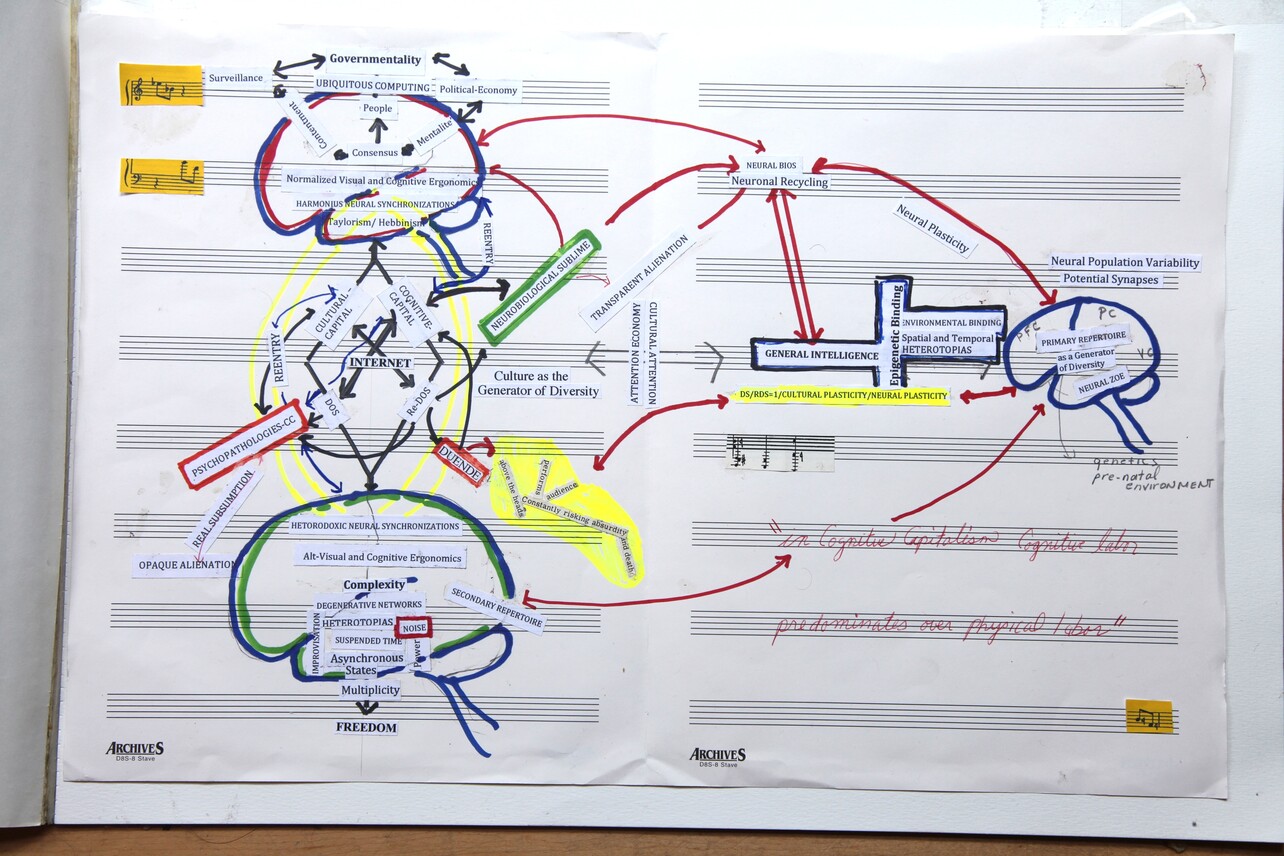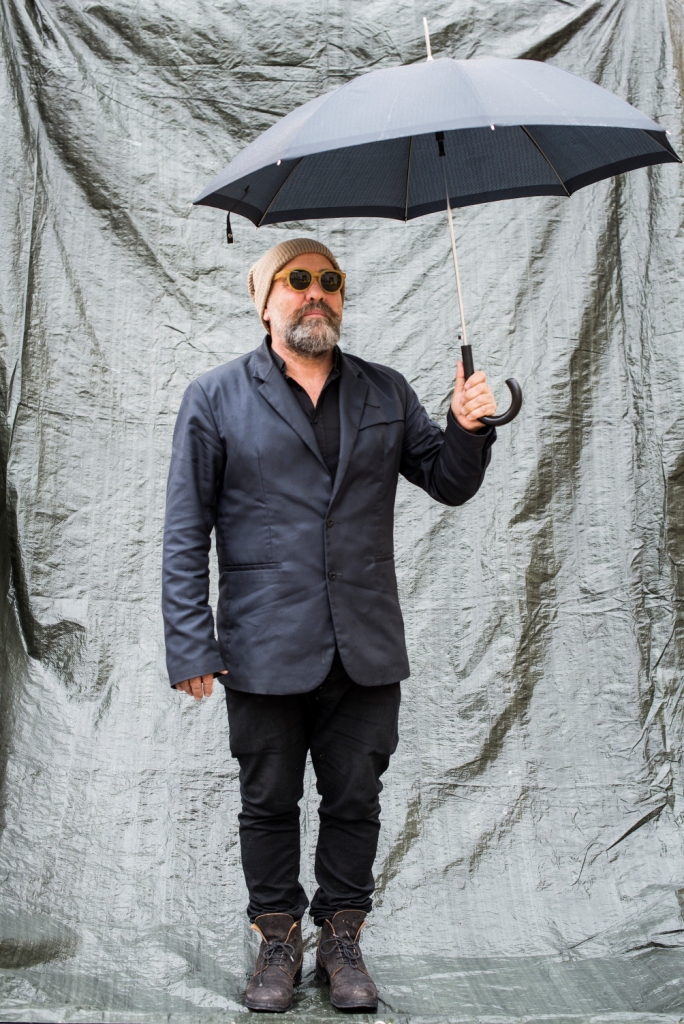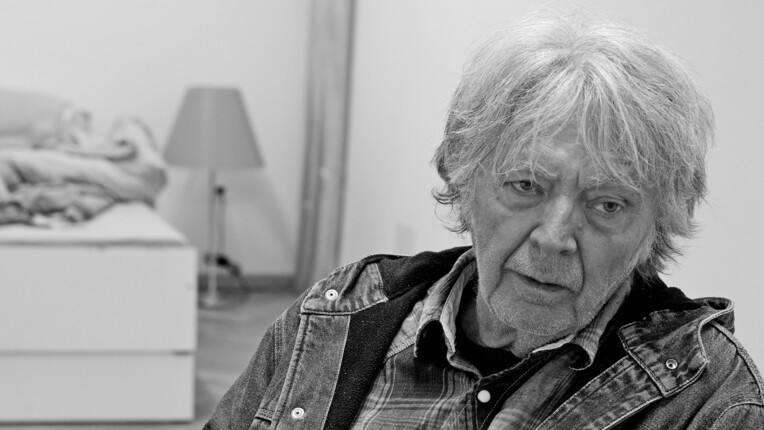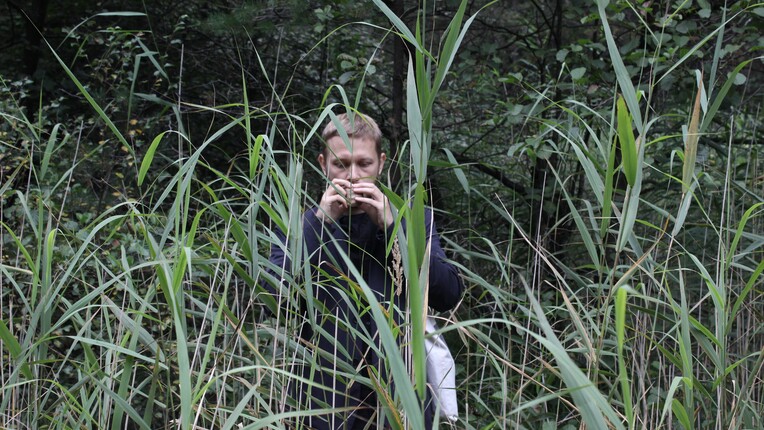
Warren Neidich: Breaking the Noise Barrier
Artist-in-Residence Warren Neidich talks about his works and project for the upcoming exhibition "Connecting Sound Etc."
As a post-conceptual artist, your multidisciplinary works investigate the ways in which art forms change/impact on the developing brain; a concept that you have called Neuroaesthetics, or Neuropower [in reference to Foucault's biopower] — can you expand on this, and please explain “Art Before Philosophy not After”.
The notion of a post-conceptual artist as expressed in my work on paper Art Before Philosophy not After challenges some of the initiating conditions of conceptual art in which art production performed a bridging condition between philosophy and art. Artistic responses of conceptual art in its early or conceptual phase concerned encoding and translating philosophical ideas into forms of artistic product. It simply reoriented modulated semiotic flows across disciplines transversally in the desire to strip art works of their aesthetic value. However Art should never simply be a transcription or translation of philosophical ideas, for instance, an engagement with the philosophy of Kant or Hegel. Art should mutate the conditions of the social-political-spiritual-psychological relations that constitute the cultural field and as such create moments and spaces of deregulation and disorientation that challenge the sensible, the truth and understanding. As such new forms of discursive practices need to be materialized in the context of philosophy mutating its tectonic epistemological structure in order to create new forms of comprehension. This is art’s estranged ontologic relationship to theory. Importantly post-Conceptualism also intuits that the resulting discursive and iconic fields have implications for the brain and mind to which it is tethered. Newly formed cultural landscapes and fields have the potential to sculpt the neural plasticity of the brain. This bi-optic power of art to sculpt the cultural plasticity, the limits of cultures to change and incorporate new others, and the neural plasticity, the ability of the brain to be sculpted by culture, is the key to the power of art. Artists must realize this and take hold of this power again.Neuropower is a key component of Cognitive Capitalism today. It is the most recent manifestation of biopower and instead focusing on the body sovereignty and governmentality reorient their focus upon the regulation of the potential of mental processes. Cognitive capitalism is now in its later phase in which the factory of the brain is the new focus of the normalizing apparatuses of contemporary capitalism. This is neither the space nor the time to elaborate upon this notion in the detail it deserves. Let me simply state that it is made up of three components. First and foremost for us here is that it acts upon the child’s and to some extent the adult’s neural plasticity to produce a future consumer citizen. With new powerful software agents this is becoming ever more evident. Secondly it acts to decrease the variability inherent in the cultural landscape which has implications for the way this variability is coupled to the brains inherent variability. This as Gerald Edelman and Olaf Sporns have suggested has implications for the complexity of the epigenetically developed brain. Epigenesis is a word that means how the environment acts upon the unfolding of the genetically inscribed morphology of the brain to modulate it: tethering it to the contingencies of the world that it interacts with. Language development in children depends for instance what language ecology- i.e. French German Chinese and Swahili- that the child encounters during critical periods of language development in his/her early life. Lev Vygotsky‘s notion of how interpersonal relations construct intrapersonal ones is essential to us here. Thirdly through different techniques emanating from the field of consumer neuroscience and neuro economics areas of the brain important for decision making, brand preferences and prognostication called the prefrontal cortex are now being prodded, coaxed and assaulted. These then form the new and future dispositifs of power’s engagement with the material architecture of the brain. I call this cynical materialism. In my work Resistance is Futile/Resistance is Fertile I made for the exhibition Protections curated by Adam Budak and Christine Peters in 2006 at the Kunsthaus Graz I addressed some of these issues. I have today extended this argument in order to develop some possible therapies for this condition. I am calling for an Emancipatory Materialism in the World Picture/Cinema and the Brain too.

Warren Neidich: Resistance is Futile/Resistance is Fertile in the exhibtion Protections, curated by Adam Budak and Christine Peters, Kunsthaus Graz, Graz, Austria, 2006
In the late 1990s and early 21st century memory in its relation to the archive played a significant role in my work. Actually it really started in the late 1980s with my photographic work American History Reinvented in which I used re-enactment strategies to investigate the role of the photographic archive in the sculpting of collective memory or museum archive. The work also challenged the positivist accounts of the role of technology as a space for continued progression in the arts through the use of anachronistic photographic processes like albumen, tin types and Polaroid which created folds in the linear and narrative accounts of photographic history. Finally it drew attention to the role of the photographic as not simply a documentation process for events but an event in itself. Every photograph is alive and performs events of engagement with the mind’s own archive; its long-term memory. It superimposes itself and entangles with that archive mutating its very conditions and as such the very notion of what constitutes ones’ past.
Later on when I began writing the essays for my book of collected essays Blow-up: Photography, Cinema and the Brain (DAP 2002) I advanced this and its corollary notion in my essay of the same title. I proposed that in fact the character of the photographer Thomas, the main character of the film, who has a nervous breakdown at the end of the film indicated by his picking up and throwing imaginary tennis balls back onto a court where two mimes are playing a game of imaginary tennis, is the result of two conflicting and competitive memory systems. These conflicting memory systems result from on one hand his relation to natural memories as a result of living in the natural world and the other the product of a long extended relationship with his self produced photographic archive, the photographs he has taken in his life, with its intense affectivity. Importantly it is this photographic memory which is a more powerful and dominating a stimulus for his mind’s attention and thus creates more intense memories. In fact the movie concerns his lack of faith in his own memories when confronted by the conflicting facts of the photographs of a murder he thinks he may have witnessed. The theft of his photographs from his studio is a catastrophic event as it deletes the physical evidence of that murder, delinking his second memory system from their referents, leaving him amnesic.
Photographic images as Virilio contends are engineered for preferred consumption, which he names phaticity from the word emphatic, and therefore call out to the minds attention more efficiently resulting in the sculpting memories which are attention dependent. Efficient memories and their structural and functional analogues in the brain’s neurons and synchronizing oscillatory potentials maintain their viability as active agents in consciousness production whereas those neurons, networks and assemblages which are not undergo what is called apoptosis or cell death. This is related to the process which Lukacs called reification- the process whereby human beings become dominated by things and become more thing-like themselves. In this case memory itself was dominated by images of things and memory itself became more artificial- a kind of mental reification. As such these two forms of memory simultaneously engage the mind’s eye and compete for being in consciousness. As such they create a kind of recursive schisis of contemplation itself- as Thomas’s world picture manifests itself as a condition in flux- seen through the scrim of rival and non-complimentary mental archive conditions.
You are a contributing artist to the exhibition Connecting Sound Etc. at freiraum quartier21 INTERNATIONAL — could you tell us more about your project for this exhibition and how the idea of dedicating an exhibition to cables interests you as an artist? Did you think about cables and sound as a medium for art before you were invited to participate in the upcoming show Connecting Sound Etc.?
My Duende Neon work is a diagram or cartographic map of the different flows that constitute my theories of a becoming cultured brain. More specifically how noise and improvisation through their bringing about difference and variation in the cultural landscape producing other neural architectures and the possibility for alternative forms of thought. Before delineating this relationship in more detail some further remarks are necessary.
The thesis essential to my theories of the power of artistic production depends on its ability to produce variation and diversity. I am referring to all forms of diversity or heterogeneity, be it in the form of objects, things, relations, human beings or cultural conditions. Art is a generator of diversity and it is this quality that it finds its power as a modifier of the brain’s potential. At birth the brains degree of neuronal, synaptic, and dendritic variability, what the famous neuroscientist Gerald Edelman calls the Primary Repertoire is only matched by the diversity of that of the worlds’. At one time nature constituted that world but today more and more that world is predominated by institutionally contrived cultural production, for instance, planned urban space as it becomes a platform for neoliberalism and artworks exhibited in art fairs as they become pure commodity. As such arts power is being usurped. Why is this important and what are its political-social-psychic manifestations? Every brain and mind samples the world differently and is called out by differing concretions of meaning which arise in the cultural landscape through process of emergence no matter how sovereignty attempts to restrict and control this process. Noise and improvisation accentuate this emergence and production of difference. The coupling of contingencies of differences in the world and the brain, through a process called epigenesis, interacts with the diversity emblematic of the primary repertoire to produce the next level of diversity called the secondary repertoire of the adult brain. It is with these generationally sculpted brains that the new contemporary world image is produced. This is what is called dialectic materialism and it is a process occurring in the world but in the brain as well.
For the past three years I have been working on a group of sound and improvisational performance works entitled The Sound of Cats Meowing. This phrase was used by witnesses of the first performance of Beethoven’s Fifth Symphony who when exiting the theatre described to a journalist what they had just heard as the sound of cats meowing in the night. How something which we think of today as so traditional could have produced such a reaction was interesting to me. Was this a result of the mutating conditions of culture, the conditions of something happening in the brain or both? Was this phenomena the same kind of reaction that people had to John Cage’s work 4 minutes and 33 seconds the first time they encountered it? Can we find analogues in the visual arts as well like Duchamp’s Fountain of 1917 that caused a scandal at the exhibition of the Society of Independent Artists or in the early forms of Pop art and Minimalism in the radical 1960s. Is the reaction of scandalous a response to cultural conditions that are beyond assimilation of a specific neural architecture a so called neurobiological sublime? Can art research such as mine that in the first place asks different questions also challenge science for the proper way to find the answers? Two works Infinite Sound of One’s Own Self-destruction and NSA-USA: Sound as Prophecy, which used sound and improvisation looked into this matter.
Performance NSA-USA: Sound as Prophecy, REDCAT Theater, The Roy and Edna Disney, Cal Arts Center, 2014 © Warren Neidich
As we mentioned above noise as a political instrument of emancipation creates conditions of anarchy in the sound environment thus reconstituting it. As such it is sampled by the brain’s variation and coupled to those anarchic patterns of difference that emerge between the manifold of cultural memory that was and the new contingencies which the deregulated noise forms have created. This constitutes the power of noise as a neuromodulator of the brain’s potential as other. The factory of the brain which is an ontogenetically determined by the synchronicities of neo liberalism through what I referred to as the epigenetically constrained developmental process, can not make sense out of this noise and anarchic experience. I used the term neurobiologic sublime above. It is outside its capacities of control and capitalist domination. On the other hand the brains variability creates a platform condition which enables other, as yet underdeveloped and unfulfilled neural network configurations, the brains pluripotentiality, to be stimulated and produced thus forming the conditions of other possibilities for sense to be made from non-sense. This is the emancipatory capacity of Noise and Improvisation.

How do you translate a text that is not a text? How do you perform a score that is not a score? Townhouse Gallery, Cairo, 2013
Having exhibited at the MAK in Vienna and the Kunsthaus in Graz, you are not unfamiliar with Austria. You have also held artist residencies all over the world. What has changed from when you started out as an artist — perhaps you could also talk about your essay 'The Artist Residency in the 21st Century: Experiments in Cultural Potentiality and Contamination' written in response to David Cameron's veto of the European treaty in 2011.
In the essay I wrote entitled 'The Artist Residency in the 21st century' which by the way is a shorter version of a longer essay in the making I contended that the nature of the purpose of the residency had shifted. In former times artists from all corners of the world were interned in residencies in order for them to be indoctrinated by the cultural conditions of the host country. This artist or student then went back to their native land where they then indoctrinated their countrymen with this new knowledge. This mechanism of cultural colonialism and domination was entangled with the conditions of industrial capitalism which needed to create world markets. Cultural indoctrination was part of an overall paradigm of consumer indoctrination. The alienation produced by the lack of use value in the colonized country context could be overcome by the production of what Jean Beaudrillard called its sign value which needed to be learned. The former cultural resident became its messenger. In today's tertiary capitalism delineated as it is by service, communication and attention economies distributed on a global scale a mutation in the systems of production distribution and exchange have changed this equation. We are involved in a complex network culture of economic interdependencies of production and consuming. European countries have a more balanced relationship with other countries and they are more interdependent. This is reflected in the nature of the purpose of the residency. The resident now is a cultural emissary visiting and producing in his host country as a messenger from his native land. In former times the immigrant artist's culture was considered different and sometimes inferior. His invitation was based on the idea of nurturing and education a model similar to that of the Christian Missionaries in Central and South America that almost destroyed the native indigenous cultures they found there. Today through the intensive re-education of the past two generations of European students by theoriticians of cultural history and post-colonialism especially in the cultural spheres a new appreciation of cultures of others is in sway. Of crucial importance were two exhibitions that changed the conditions of the cultural landscape and have had repercussions for the idea of the residency. Documenta X curated by Catherine David and then Documenta X1 curated by Okwui Enwezor. These exhibitions have had important effects on whole generations of curators who now began to understand artworks made by non-European artists in the context of globalization as it effected the production of the real in its political its economic and its aesthetic sense. These legions of curators have had an enormous effect challenging the whole nature of what art history is. Once dominated by purely aesthetic interests it has undergone a cultural turn. As such artist visitors play an important role in educating their host countries as to the subtleties of their own native cultures which now entangles itself in the host country's cultural landscape with the help of this newly educated army of cultural curators. These concerted efforts have the effect of changing the morphology of the cultural landscape as well as releasing implicit relations which emerge. I know this is a utopian and optimistic vision and a more cynical one always lurks in the shadow as the expression of the power of capitalism to subsume difference and change always needs new actors to create difference. In this case utilizing it to produce better global strategies for consumer marketing of their just in the nick of time production and desire for an educated attentive global subject. But I want to believe in this vision and I want to believe that along with it is the potential to sculpt new circuits in the brain resulting from new patterns of distributions- cultural redistributions- that call out to the brain difference and pluripotential.
But this incursion of the formerly colonial subject now turned cultural emissary in a reverse direction has the power to create multiplicities of multiple singular voices chanting together other rhythms in the heterogeneous mixologies that are destabilizing to the homogeneous regimes of nations. As such they present a challenge to the host country which must integrate these new voices and tether it to their own cultural dispositions. Sometimes xenophobia is the response and sometimes it is generosity.






